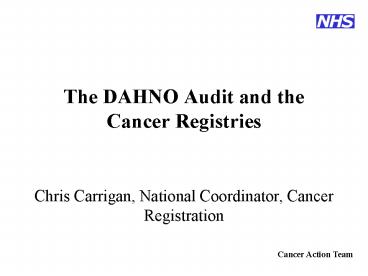The DAHNO Audit and the Cancer Registries - PowerPoint PPT Presentation
1 / 20
Title:
The DAHNO Audit and the Cancer Registries
Description:
A standard dataset is collected for all new incident cases. For England, approximately 225,000 new cases ... Confusion between recording cytology and histology ... – PowerPoint PPT presentation
Number of Views:36
Avg rating:3.0/5.0
Title: The DAHNO Audit and the Cancer Registries
1
The DAHNO Audit and the Cancer Registries
- Chris Carrigan, National Coordinator, Cancer
Registration
2
Cancer Registration
- A standard dataset is collected for all new
incident cases - For England, approximately 225,000 new cases are
registered each year - Of these, 8000 are head and neck cancers
3
Registry/ DAHNO collaboration
- Key Partnership
- Data Quality Assurance
- internal quality/consistency of data
- produce first output analyses
- Provision of Population Denominators
- Data Analysis
- Collaboration through registries National
Analysis Group, key staff from South West and
Oxford
4
Data Quality
- What is Data Quality?
- Quality Control
- Quality Assurance
- Manual vs. Automated
5
Comparisons to DAHNO?
Medical Records
DAHNO System
Online Forms
Manual Collation
DAHNO Database
Automated Collation
Supplier Information Systems
6
Manual vs Automated Assurance
- Manual
- Expensive
- Can be highly detailed and abstract
- Highly skilled
- Interpretation error
- Automated
- Cost efficient
- Requires multiple electronic sources
- Very specific
- Absolute (interpretation)
- What does each method test?
7
Automated Quality Assurance
- Cross-registry collaboration (led by Trent and
Thames via Lucada) - Additional validations devised with Lead
Clinician and Project Manager (cross-checks for
consistency) - 100 initially identified, essentials agreed
8
Manual Quality Assurance
- Small scale QA exercise using audit data
- Involves manual re-abstraction of the whole
dataset by trained registry staff for randomly
selected cases - With thanks to Carol Lister at NYCRIS
9
Pilot Data Quality Exercise
- Registries defined methodology
- Cover one whole cancer network
- Pilot cancer network within the NYCRIS area
- 3 Trusts 6 hospitals
10
Method
- A sample of records to be quality assured via
data re-abstraction - Time period cases submitted to audit database
between July-September 2004 - Each Trust asked to identify 50 records submitted
during time period - 20 casenotes requested from each of these
11
Method
- Each Trust asked to identify 50 records submitted
during time period - 20 casenotes requested from each of these
- Data abstracted onto data collection form by two
experienced NYCRIS data abstractors - Results compared with original submissions to
audit database
12
Problems in Reabstraction (1)
- NHS number missing from most of the sample
casenotes for one hospital crucial to the
matching exercise - Lack of information in casenotes about MDT
meetings only one hospital had a standard
recording sheet - (Sometimes several meetings, but details often
not in casenotes)
13
Problems in Reabstraction (2)
- Data definitions some just different from
cancer registry definitions, some open to
interpretation (even using the manual) - e.g.
- Co-morbidity
- Watchful waiting
14
Comparison of results
matched data items by Trust
15
Results (cont)
- Postcode different from postcode at diagnosis
- Referral dates problems when referral pathway
not straightforward
16
Results (cont)
- For one hospital, 13 specialist referral dates
were missing - Diagnosis date wide variation in interpretation
- Primary site diagnosis 41 had site recorded,
when a more definitive site should have been used
17
Results (cont)
- Basis of diagnosis missing for 21 cases
- Confusion between recording cytology and
histology - Staging could have been added for 30 cases from
CT scans or investigation results
18
Results (cont)
- Treatment in some cases, all treatment details
missing in others only partially completed. - For one hospital, treatment recorded for all
cases, where only investigative had been
performed - RT details missing for 27 cases
- Death details missing for 37 cases
19
Conclusions (cont)
- A time-consuming exercise (4 weeks of trained
staff time for 71 cases) - Significant variations, including
- Important details missed
- Lack of definition (e.g. site)
- Illogical details added
20
Conclusions (cont)
- Balance between Quality Control and Quality
Assurance - Not getting it right first time takes time,
energy, effort and money to discover further down
the line - Improve the Quality Control on entry (unpopular)
21
The DAHNO Audit and the Cancer Registries
- Chris Carrigan, National Coordinator, Cancer
Registration

